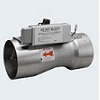Room Pressure Control
To prevent the spread of harmful substances and keep the indoor air clean, room pressure control manages the volume of supply air and exhaust air to create an airflow in one direction, either into or out of a room. When the exhaust volume is greater, negative pressure prevents harmful substances in a room from spreading outside, and when the supply volume is greater, positive pressure keeps the air inside the room clean.
- “Negative pressure” is touted for infection control, but what is it?
- Places other than hospitals that need room pressure control
- A flexible air handling system is essential in case of emergency

“Negative pressure” is touted for infection control, but what is it?
By adjusting the volume of supply air (air sent into a room) and exhaust air (air sent out of the room), airflow can be made to go either out of or into a room. That is because air flows from high pressure to low pressure.
An example is when an exhaust fan is turned on because of odor in a bathroom. The exhaust fan makes the pressure inside the bathroom slightly lower than the pressure outside. This state is called negative pressure. When there is negative pressure inside a bathroom, airflow is created from the area of high pressure outside the bathroom (e.g., a hallway) to the low-pressure area in the bathroom. It is therefore possible to prevent odor from coming out of the bathroom.
By using this principle and controlling supply and exhaust air, clean areas and contaminated areas can be kept separate for separate operations. In the case of a bathroom, air exhaust is accomplished by mechanical equipment (a fan), and air supply takes place naturally. This is one type of ventilation that we will call “type 1.” There is also a second type that we will call “type 2,” in which only the supply air is handled by mechanical equipment, and finally, a “type 3” ventilation, in which both supply and exhaust air are handled by mechanical equipment. In homes, type 1 and type 2 ventilation are often used, but in places like medical institutions, to ensure the required amount of ventilation and one-way airflow from clean to contaminated areas, type 3 ventilation is used for air supply and exhaust. In a hospital room with infectious patients, to prevent viruses and other pathogens from spreading outside, the room is kept under negative pressure (where there is more exhaust air than supply air) to contain the pathogens. Conversely, for a place like an operating room that must be clean, the room is kept under positive pressure (more supply air than exhaust air) to prevent viruses from entering.
Places other than hospitals that need room pressure control
As explained above, adjusting the balance between the incoming (supply) air and the outgoing (exhaust) air to create negative or positive pressure is called room pressure control. It is not always important to set and strictly enforce a numerical target like “−10 Pa compared with atmospheric pressure.” The main purpose of room pressure control is to prevent the spread of harmful substances from the room to the outside (for negative pressure) or maintain the cleanliness of the room (for positive pressure), so what is important is maintaining an inward or outward one-way airflow.
It is not only medical institutions that use room pressure control. Various types of facilities must prevent the entry of dust and contaminants, such as food processing plants and semiconductor fabrication plants. Conversely, garbage disposal plants must manage odors. Above all, room pressure control is needed in research facilities where strict safety management is required. The room pressure changes when a door inside a building is opened, so multiple small rooms called anterooms or airlock rooms are used to maintain incremental pressure differences and one-way airflows.
A flexible air handling system is essential in case of emergency
In addition, variable air volume (VAV) units*1 are used for room pressure control in hospitals that have multiple hospital rooms. There are ducts for supply and exhaust air all around a hospital ward, but the ease with which the air flows varies depending on the length and shape of the ducts. By installing VAV units in the duct, it is possible to accurately control the volume of supply and exhaust air in each room in order to maintain a safe and stable room pressure environment. In other words, it is possible to provide the room pressure that is suitable for each hospital room.
This kind of advanced room pressure control is now attracting attention as a countermeasure for the current pandemic. With the spread of COVID-19, shortages of hospital beds have been reported. For the provision of medical care, it is ideal to have enough beds for infectious patients in case of a pandemic, but from the perspective of hospital management, it is not practical to constantly keep many beds for infectious patients, since the beds are unlikely to be used in normal times. For that reason, people in various places are now thinking for the first time about how the room pressure in hospital rooms is controlled. With the installation of a system that controls supply and exhaust air and enables pressure control on an individual room basis, even rooms normally used for general beds can be switched to negative pressure rooms for infectious disease control with the flick of a switch if an emergency arises. Of course, it is preferable not to have a pandemic, but in an era when you do not know what will happen, it is good to always be prepared.
*1 Variable air volume (VAV) unit
A unit that can freely set and control the volume of air supplied from the air conditioning outlet and the volume of exhaust air vented. Since it is easy to control the air volume individually in various locations, VAV units are widely used for adjusting the cooling and heating capacity and controlling room pressure.


